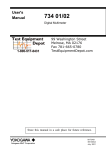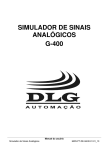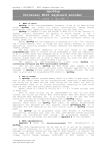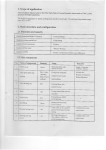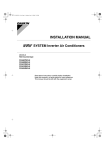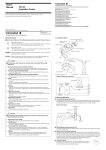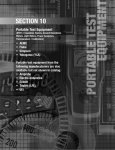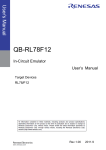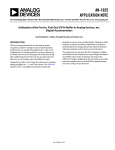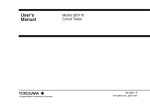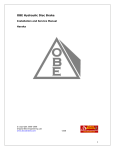Download 733 User Manual
Transcript
Safety Precautions User’s Manual To ensure safe use of the product, strictly adhere to the precautions indicated by the following symbols throughout this manual. Model 73301/ 02/ 03 Digital Multimeters Indicates a hazard that may result in the loss of life or serious injury of WARNING the user unless the described instruction is abided by. Indicates a hazard that may result in an injury to the user and/or physical CAUTION damage to the product or other equipment unless the described instruction is abided by. The instrument and this manual also use the following safety symbols: Caution This symbol indicates that the operator must refer to an explanation in the instruction manual in order to avoid the risk of injury or death of personnel and/or damage to the instrument. Double Insulation This symbol indicates double insulation. AC Voltage/Current This symbol indicates AC voltage/current. DC Voltage/Current This symbol indicates DC voltage/current. Fuse This symbol indicates a fuse. Ground This symbol indicates ground (earth). 2) SELECT key This button is enabled only if the multimeter is in one of the following measurement modes. • V: In this mode, the key selects the frequency measurement in hertz (73302 & 73303). In this mode, the key selects the AC voltage measurement in an average value. (73303) • mV: In this mode, the key selects AC voltage measurement in milli-volts. • Ω: In this mode, the key selects among the continuity check, diode test, and temperature measurement. • : In this mode, the button adjusts the stray capacitance of the testing leads and the multimeter itself, to zero (73302 & 73303). • µA/mA/A: In this mode, the button selects AC current measurement. 3) RANGE key Allows the operator to select the measuring range manually (the display shows the R • H symbol). The range increases as the button is pressed. To return to the normal auto-ranging mode, hold down this button for at least one second until the display shows " AUTO ." 4) D-H/A-H key Selects between the DATA HOLD and AUTO HOLD functions (the display shows the D • H symbol when in the DATA HOLD mode, and the A • H symbol when in the AUTO HOLD mode). 5) REL/% key Selects between REL and % calculations (the display shows the REL symbol when in the REL mode, and the REL and % symbols when in the % mode). 6th Edition: Jan. 2007(KP) Connect the calibrator to the multimeter with the calibrator’s testing leads. Before carrying out calibration, read the instruction manual of the calibrator. Calibration temperature and humidity: 23±3°C, 55%RH or below Leave the multimeter for 30 minutes to enable it to reach room temperature before carrying out calibration. • Temporarily remove the testing leads from the multimeter before switching between DC and AC, or voltage and current during calibration. To calibrate the multimeter: Note: Start calibration of the mV range (calibration of other ranges will become possible after mV calibration has been completed). a) Turn the function switch from the OFF position to the mV position while pressing the SELECT and RANGE keys at the same time. (The display shows the CAL symbol then the PASS symbol.) b) Press the SELECT key. (The display shows the “- “ symbol.) c) Press the D-H/A-H key twice. (The display shows the “- - - “ symbol.) d) Press the RANGE key. (The display shows the mV symbol.) e) Connect the multimeter to the calibrator with the testing leads. f) Set the calibrator to 380 mVDC as an input to the multimeter. g) Press the D-H/A-H key. (After the value stabilizes, press the D-H/A-H key to confirm the calibration value.) h) Carry out calibration of other ranges by repeating steps f) and g) in accordance to Table 1. i) To quit calibration, turn the function switch back to the OFF position. Table 1. Input Signal for Calibration Range 400 mVDC 4 VDC 40 VDC 400 VDC 1000 VDC VAC (RMS) VAC (AVG) Input 380 mV 3.8 V 38 V 380 V 1000 V 3.8 V at 60 Hz 3.8 V at 60 Hz Range 400 µADC 4000 µADC 40 mADC 400 mADC 4 ADC 10 ADC AAC Input 380 µA 3800 µA 38 mA 380 mA 3.8 A 10 A 38 mA at 60 Hz Range 10 nF 100 nF 1 µF 10 µF 100 µF 1000 µF <5> REL/% key <4> D-H/A-H key <1> Function switch Input 9 nF 90 nF 0.9 µF 9 µF 90 µF 1000 µF a) Turn the function switch from the OFF position to the Ω position. b) Plug the black testing lead into the COM input terminal and the red testing lead into the •V•Ω• input terminal. c) Connect the testing leads to the circuit under test and then read the meter when it stabilizes. • Continuity Check ( ) CAUTION • Diode Test ( ) CAUTION To avoid damage to instrument Turn off the power to the circuit under test before starting measurement in order to prevent any excess voltage from being applied to the multimeter. Input terminal 6) Display Description Symbol and Unit Maximum Input Voltage III 600 V AC/DC II 1000 V AC/DC REL D•H A•H CAT.I CAT.II • • • • CAUTION To avoid damage to instrument Turn off the power to the circuit under test before starting measurement in order to prevent any excessive voltage from being applied to the multimeter. WARNING Measurement Category (CAT) CAUTION • Resistance Measurement (Ω) a) Turn the function switch from the OFF position to the Ω position. b) Press the SELECT key to display the symbol. • c) Plug the black testing lead into the COM input terminal and the red testing lead into the V•Ω• input terminal. d) Connect the testing leads to the circuit under test. If the circuit is continuous (no more than approximately 20 Ω, the buzzer sounds. <3> RANGE key ■ Measurement Category (CAT.) The restrictions on the maximum voltage level for which the 73301, 73302 and 73303 multimeters can be used, depend on the Measurement categories specified by the safety standards. User Calibration Function It is recommended that the instrument be calibrated periodically. Use the keys on the faceplate of 733 series of multimeters to carry out calibration. Use the calibrator with ten times the accuracy of 733 series. Do not mistake the following for a malfunction! If the 400 mV range is selected and the testing leads are left open-circuited, the multimeter may give a certain reading. This does not affect your measurement. <2> SELECT key ■ To avoid electric shock • Do not use deteriorated or damaged testing leads. Check testing leads before use. • Do not use the instrument if there is any damage to the casing or when the casing is removed. • Disconnect testing leads from the circuit under test before opening the casing to replace the batteries or for any other reason. • Avoid using the instrument if it has been exposed to rain or moisture or if your hands are wet. ■ To avoid electric shock or fire Do not use the instrument in an atmosphere containing any flammable or explosive gases. IM 73301E NOTE To avoid damage to instrument Turn off the power to the circuit under test before starting measurement in order to prevent any excessive voltage from being applied to the multimeter. <6> Display WARNING Store this manual in a safe place for future reference. c) Connect the testing leads to the circuit under test and then read the meter when it stabilizes. For measurements performed on circuits not directly connected to MAINS. For measurements performed on circuits directly connected to the low voltage installation. CAT.III For measurements performed in the building installation. R•H AUTO RMS AVG CAUTION • Do not use the multimeter near noise-emitting equipment or where there may be a sudden change of temperature. Otherwise, the instrument may give an unstable reading or errors. • Do not wipe the instrument using any organic solvent such as benzine or paint thinner, as this may damage or discolor the front panel. Use a dry cloth to clean the instrument. • Do not leave the multimeter exposed to direct sunlight or in a hot and humid location such as the inside of a car, for any prolonged length of time. AUTO POWER OFF nF, µF mV, V AUTO POWER OFF indicator Unit for capacitance measurement Unit for voltage measurement µA, mA, A Ω, kΩ, MΩ °C Unit for current measurement Unit for resistance measurement Unit for temperature measurement Hz % Unit for frequency measurement Unit for percentage calculation Lit when the batteries are low +– a) Turn the function switch from the OFF position to the Ω position. (For 73301 turn to the position.) b) Press the SELECT key to display the symbol. • c) Plug the black testing lead into the COM input terminal and the red testing lead into the V•Ω• input terminal. d) Connect the testing leads to the diode under test and then read the meter when it stabilizes. (1) Forward-bias Diode Test Connect the black testing lead to the cathode and the red testing lead to the anode. (2) Reverse-bias Diode Test Connect the black testing lead to the anode and the red testing lead to the cathode. Description Lit when in DC-mode measurement Lit when in AC-mode measurement Polarity indicator-lit when the polarity is negative Lit when in diode test Lit when in continuity check REL calculation indicator DATA HOLD indicator AUTO HOLD indicator Manual range indicator AUTO RANGE indicator AC root-mean-square voltage measurement indicator AC average-voltage measurement indicator • Temperature Measurement (TEMP) CAUTION To avoid damage to instrument Turn off the power to the circuit under test before starting measurement in order to prevent any excessive voltage from being applied to the multimeter. a) Turn the function switch from the OFF position to the Ω position. b) Press the SELECT key three times to select the TEMP mode (the display shows the °C symbol). c) Plug the black lead of the optional 234901 thermistor measuring probe into the COM input terminal and the red lead into the •V•Ω• input terminal. d) Connect the testing leads to the circuit under test and then read the meter when it stabilizes. Bar graph indicator NOTE • Radiation immunity affects the accuracy of 733 Series digital multimeter under the conditions specified in EN 61326-1. • If equipment generating strong electromagnetic interference is located nearly, the testers may malfunction. Components 1) Function Switch Turns off the power or selects the measurement mode. OFF: Turns off the power. V: AC voltage measurement V: DC voltage measurement mV: DC voltage measurement in milli-volts Ω: Resistance measurement : Capacitor check (73302 & 73303) : Diode test (73301) µA/mA/A: DC/AC current measurement Measuring Instructions • Current Measurement (µA/mA/A) CAUTION CAUTION To aboid damage to Instrument or equipment • Before starting measurement, make sure that the function switch mode is set and the testing leads are plugged into the terminals required for the desired mode of measurement. • Temporarily remove the testing leads from the device under test before operating the function switch. To avoid damage to instrument Check which mode the function switch is set to before starting measurement. • AC Voltage Measurement ( V) a) Turn the function switch from the OFF position to the V or mV position. b) Press the SELECT key when the mV mode is selected (the display shows the ~ symbol). c) Plug the black testing lead into the COM input terminal and the red testing lead into the • V•Ω• input terminal. d) Connect the testing leads to the circuit under test and then read the meter when it stabilizes. Note: When the ~V mode is selected, the AC voltage can be displayed as an average or effective value. Press the SELECT key to display the AVG or RMS symbol (73303). • DC Voltage Measurement ( V) a) Turn the function switch from the OFF position to the V position. b) Plug the black testing lead into the COM input terminal and the red testing lead into the V•Ω• input terminal. • a) Turn the function switch from the OFF position to either the µA, mA or A position. (If the magnitude of the current being measured is not known, select the A position. Make sure the current being measured is no more than 0.4 A before the µA or mA position is selected.) b) Press the SELECT key to select DC or AC measurement. c) Plug the black testing lead into the COM input terminal and the red testing lead into the A input terminal. If the current is in the order of milli-amperes or less, plug the red testing lead into the µA • mA input terminal. d) Connect the testing leads to the circuit under test and then read the meter when it stabilizes. • Capacitor Check ( ) When this function is complete, turn the function switch back to the OFF position and turn-off the multi meter. CAUTION To avoid damage to instrument Turn off the power to the circuit under test before starting measurement in order to prevent any excess voltage from being applied to the multimeter. a) Turn the function switch from the OFF position to the position. b) Plug the black testing lead into the COM input terminal and the red testing lead into the • V•Ω• input terminal. c) Open the testing lead and press the SELECT key to adjust the stray capacitance to zero (the display shows 0.00). d) Connect the testing leads to the capacitor under test and then read the meter when it stabilizes. When the capacitor check is below the capacity at zero calibration, “0.00” is displayed until the power off. NOTE Do not mistake the following for a malfunction! Zero calibration is only effective when the 10 nF range is selected. • Frequency Measurement (Hz) CAUTION To avoid damage to instrument Check which mode the function switch is set to before starting measurement. a) Turn the function switch from the OFF position to the V position. b) Press the SELECT key to select Hz measurement (the display shows the Hz symbol). c) Plug the black testing lead into the COM input terminal and the red testing lead into the • V•Ω• input terminal. d) Connect the testing leads to the circuit under test and then read the meter when it stabilizes. NOTE Do not mistake the following for a malfunction! If the Frequency measurement range is selected and the testing leads are left open-circuited, the multimeter may give some kind of reading. This does not affect your measurement. AUTO HOLD Function The 733 series of multimeters can automatically retain the measured value when the testing leads are handled as described below. a) Press the D-H/A-H key to select the function. (The display shows the A • H symbol.) b) Connect the testing leads to the object under test. c) When the reading stabilizes, the buzzer sounds. d) Remove the testing leads from the object under test. e) The multimeter now shows the measured value that it retains. f) You can repeat steps b) to e) as many times as you like as long as the display shows the A • H symbol. g) To cancel this function, press the D-H/A-H key once again. (The A • H symbol disappears.) NOTE Do not mistake the following for a malfunction! • In DC/AC voltage measurement, the AUTO HOLD function is only available for ranges greater than the 4 V range. • This function is not available for Capacitor check, Temperature-mode measurement, Continuity check and Frequency measurement. • The AUTO HOLD function cannot be applied to unstable signals. REL&% Calculation Function The 733 series of multimeters can calculate relative values or differences, and percentage values from the reference measurement values. (1) REL calculation Subtracts the reference value from the measured value to display the relative value or difference. a) Enter the reference value. b) Press the REL/% key to display the REL symbol. c) Enter the measured value. d) The display shows the relative value or difference. (2) % calculation Calculates and displays the percentage value according to the following equation: % value = (reference value - measured value)/ reference value a) Enter the reference value. b) Press the REL/% button to display the REL symbol. c) Enter the measured value. d) Press the REL/% button again to display the % symbol. e) The display shows the percentage value. AUTO POWER OFF function The multimeter automatically turns off if no key is pressed for a period of 20 minutes. The multimeter will beep for approximately 30 seconds to alert the operator before the AUTO POWER OFF function takes effect. (Pressing any key while the multimeter is beeping postpones the power-off time.) Pressing any key once after the power to the multimeter is automatically turned off switches the multimeter on again. To cancel the AUTO POWER OFF function, hold down the D-H/A-H key and then turn the function switch from OFF to the desired position of any measurement mode. (The AUTO POWER OFF indication turns off when the function is canceled.) To enable the function once again, temporarily turn the function dial back to the OFF position, and then select the desired measurement mode. Battery Replacement If the batteries fall below the normal operating voltage, the symbol turns on. If this happens, replace the batteries with new ones (two AA-size [R6 or LR6] batteries). 2. Performance Test conditions: Temperature and humidity: 23°C ±5°C at 80% RH or below Accuracy: ±(percentage of reading + number of digits) Note: Each response noted below is a value measured in the Range Hold mode. Resolution Accuracy 73301 To avoid electric shock • Be SURE to disconnect the multimeter from the circuit under test before replacing the batteries. • Replace both batteries at the same time making sure to position their polarities correctly. 400 mV 4 V 40 V 0.1 mV 0.001 V 0.01 V 400 V 1000 V c) 73302 & 73303 Input Resistance 10 MΩ 11 MΩ 0.3% + 1 0.2% + 1 0.1 V 1V Maximum Input Voltage 10 MΩ Range Resolution Accuracy CAUTION To avoid electric shock • Be SURE to disconnect the multimeter from the circuit under test before replacing the fuse(s). • Do NOT operate the multimeter with the casing left open. • In order to avoid damage to the multimeter or any possible accident, use fuses of the specified rating. To replace the fuse(s): a) Remove the four screws on the back of the casing. b) Open the casing. c) Remove the blown fuse from the fuse holder. F1: Type A1518EF d) Install a new fuse in the holder. (600 V/500 mA) protection fuse e) Close the casing and fasten it with the four F2: Type A1519EF screws. (600 V/15 A) View with the Casing Open protection fuse Specifications 1. Standard Specifications • Measurement functions: AC voltage, DC voltage, AC current, DC current, resistance, continuity, diode, temperature, frequencyNote and capacitanceNote Note: This function is not supported on the 73301 multimeter. • Additional functions: Data-hold/Automatic-hold, manual range selection, REL/%, overrange alarm, and automatic power-off • Display: LCD display that is capable of indicating a significant reading of up to 4000 countsNote in the digital display and 40 segments in the bar graph display along with the indications of the unit indication is given for positive polarity. The display also has the OL over-range and low-battery alarm indicators. Note: The most significant reading is 9999 counts for the frequency measurement. • Range selection: Manual or automatic • Measurement cycle: Digital 2.3 times per second (where the cycle for frequency measurement is once every second and 0.2 to 2 times every second for capacitor measurement). Bar graph 23 times per second • Operating temperature range: -10°C to 50°C (with guaranteed accuracy of 23°C ±5°C) with no condensation Where, the range is -10°C to 40°C for a humidity of 80%RH or below, and 40°C to 50°C for a humidity of 70%RH or below. • Temperature coefficients: Add (accuracy × 0.1)/°C at -10°C to 18°C or 28°C to 50°C • Storage temperature and humidity ranges: -20°C to 60°C; 70% RH maximum • Power supply: AA-size (R6 or LR6) batteries: 2 • Battery life: Approximately 300 hours (at DC viltage measurment, using alkaline batteries) • External dimensions: 85 (W) × 191 (H) × 40 (D) mm (excluding protrusions) • Weight: Approx. 450 g (including batteries) • Safety standards: EN61010-1, EN61010-2-031 (AC/DC 600V CAT.III, AC/DC 1000V CAT.II, Pollution degree 2) • EMC standards: EN55011 Group1 Class B EN61326-1 • Effect of radiation immunity: Accuracy range of reading: [Rated accuracy + 8% of each range] for the strength of a radio-frequency electromagnetic field of 3 V/m • Operating environment: 2000 m max. above sea level., indoors. • Withstand voltage: 5.55 kVAC 1 minute (between input terminal and casing) • Accessories: Batteries: 2 Testing leads (RD031): 1 set Instruction manual: 1 • Optional Accessories: Thermistor measuring probe (234901) 4V 0.001 V 40 V 0.01 V 400 V 1000 V 0.1 V 1V Voltage 40 - 500 Hz 500 -1 kHz 10 MΩ, <50 pF 11 MΩ, <50 pF 0.5% + 2 1% + 2 1.5% + 4 1000 VDC 1000 Vrms AC 10 MΩ, <50 pF Common mode rejection ratio: 60 dB or better at DC to 60 Hz AC frequencies (where Rs = 1 kΩ) Response: 2 sec maximum • AC Voltage Measurement ( V) (73302) - AC coupling. Based on mean-value detection and root-mean-square value calibration. Range Resolution Accuracy 50/60 Hz 400 4 40 400 1000 mV 0.1 mV V 0.001 V V 0.01 V V 0.1 V V 1V 0.5% + 2 40 - 500 Hz 500 -1 kHz 0.75% + 2 1.5% + 4 Input Impedance Maximum Input Voltage 10 MΩ, <50 pF 11 MΩ, <50 pF 1000 VDC 1000 Vrms AC 10 MΩ, <50 pF Common mode rejection ratio: 60 dB or better at DC to 60 Hz AC frequencies (where Rs = 1 kΩ) Response: 2 sec maximum • AC Voltage Measurement ( V) (73303) - AC coupling. Based on root-meansquare value detection and mean-value detection (excluding 400 mV range) and root-mean-square value calibration (excluding 400 mV range). Range 400 4 40 400 1000 Resolution mV 0.1 mV V 0.001 V V 0.01 V V 0.1 V V 1V Input Impedance Maximum Input Voltage 50/60 Hz 40 - 500 Hz 500 -1 kHz 10 MΩ, <50 pF 11 MΩ, <50 pF 1000 VDC 0.5% + 5 1% + 5 1.5% + 5 1000 Vrms AC Note Note Note 10 MΩ, <50 pF • DC Current Measurement ( A) Resolution Accuracy 73301 µA 400 µA 4000 µA 0.1 µA 1 µA mA 40 mA 400 mA 4A 10 A 0.01 mA 0.1 mA 0.001 A 0.01 A A Resolution Voltage Drop 73302 & 73303 <0.12 mV/µA 1% + 2 <3.3 mV/mA 0.5% + 2 1.2% + 2 <0.12 mV/µA 0.75% + 5 Note 1.5% + 5 Note 1% + 5 Note <3.3 mV/mA <0.1 V/A 400 Ω 4 kΩ 40 kΩ 400 kΩ 4 MΩ 40 MΩ Accuracy 73301 73302 & 73303 0.1 Ω 0.001 kΩ 0.01 kΩ 0.1 kΩ 0.001 MΩ 0.01 MΩ <0.1 V/A Maximum Input Current 400 mA The input is protected by a 500 mA/600 V fuse. 10 A The input is protected by a 15 A/600 V fuse. Response: 1 sec maximum 0.4% + 1 Note 0.5% + 1 Note 0.5% + 1 1% + 2 Maximum Input Current 400 mA The input is protected by a 500 mA/600 V fuse. 10 A The input is protected by a 15 A/600 V fuse. Measuring Current Open-loop Voltage <1.4 mA <120 µA <13 µA <1.3 µA <130 nA <3.4 V Input Protective Voltage 600 Vrms <1.3 V Response: 2 sec maximum for ranges lower than the 400 kΩ range; 10 sec maximum for ranges higher than 4 MΩ Note: Readings in the 400 Ω range are the values after zero calibration has been completed. • Continuity Check ( ) Range Resolution Range of Operation 400 Ω 0.1 Ω The buzzer turns on for resistances lower than 20 Ω. • Diode Test ( Measuring Current 0.8 mA Open-loop Voltage Input Protective Voltage <3.4 V 600 Vrms ) Range Resolution Accuracy Measuring Current (Vf = 0.6 V) Open-loop Voltage Input Protective Voltage 2V 0.001 V 1% + 2 About 0.5 mA <3.4 V 600 Vrms • Temperature measurement (TEMP) Range -50.0°C to 150°C Resolution 0.1°C Accuracy Common mode rejection ratio: 60 dB or better at DC to 60 Hz AC frequencies (where Rs = 1 kΩ) Response: 2 sec maximum Crest factor: < 3 Note: 5 to 100% of the full scale and 1000 V range is 200 to 1000 V. Range 0.1 µA 1 µA 0.01 mA 0.1 mA 0.001 A 0.01 A Voltage Drop 40 -1 kHz • Resistance Measurement (Ω) Input Impedance Maximum Input 0.1 mV Accuracy Response: 3 sec maximum Crest factor: < 3 (73303) Note: 5 to 100% of the full scale and 10 A range is 2 to 10 A (73303). Range 400 mV If a current greater than the rated value flows when the multimeter is in the current-measurement range, a protection fuse may blow. If this happens, replace that fuse. The multimeter contains the following two types of fuses: • F1 fuse: type A1518EF (600 V/500 mA) • F2 fuse: type A1519EF (600 V/15 A) mA A Normal mode rejection ratio: 60 dB or better at 50/60 Hz Common mode rejection ratio: 120 dB or better Response: 1 sec maximum 50/60 Hz Fuse Replacement 400 µA 4000 µA 40 mA 400 mA 4A 10 A 1000 V DC 1000 Vrms AC • AC Voltage Measurement ( V) (73301) - AC coupling. Based on mean-value detection and root-mean-square value calibration. a) Resolution 50/60 Hz • DC Voltage Measurement ( V) Range b) Range µA CAUTION To replace the batteries: a) Remove the four screws on the back of the casing. b) Open the casing. c) Take the battery holder out of the casing. d) Replace the batteries with new ones and install the battery holder back into the casing. e) Close the casing and fasten it with the four screws. • AC Current Measurement ( A) (73302 & 73303) - AC Coupling. Based on rootmean-square value calibration (73303) and mean-value detection and root-meansquare value calibration. Accuracy Input Protective Voltage ±1°C for 0°C to 70.0°C range; ±2°C for -30.0°C to 0°C range and 70.0°C to 150.0°C range. 600 Vrms Accuracy is the value when measured in combination with the 234901 (optional). • Capacitor Check ( Range ) This function is not supported on the 73301 multimeter. Resolution Accuracy 73302 & 73303 Input Protective Voltage 10 nF 0.01 nF 2% + 10 Readings are the values after zero calibration has been completed. 100 nF 1000 nF 10 µF 0.1 nF 1 nF 0.01 µF 2% + 5 100 µF 1000 µF 0.1 µF 1 µF 3% + 5 600 Vrms • Frequency measurement (Hz) This function is not supported on the 73301 multimeter. Range Resolution 10.00 to 99.99 Hz 90.0 to 999.9 Hz 0.900 to 9.999 kHz 0.01 Hz 0.1 Hz 0.001 kHz 9.00 to 99.99 kHz 0.01 kHz Accuracy 73302 & 7333 Input Voltage Maximum Input Voltage 0.2 to 400 Vrms 0.02% + 1 600 Vrms 0.4 to 400 Vrms 0.8 to 100 Vrms 100 Vrms AC Coupling • AC Current Measurement ( A) (73301) - AC Coupling. Based on mean-value detection and root-mean-square value calibration. Range Resolution Accuracy 50/60 Hz µA mA A 400 µA 4000 µA 40 mA 400 mA 4A 10 A 0.1 µA 1 µA 0.01 mA 0.1 mA 0.001 A 0.01 A Voltage Drop 40 -1 kHz <0.12 mV/µA 1% + 5 <3.3 mV/mA 1.5% + 5 1.2% + 5 <0.1 V/A Maximum Input Current 400 mA The input is protected by a 500 mA/600 V fuse. Calibration and Maintenance Calibration Cycle It is recommended that the instrument be calibrated once a year. (see also “User Calibration Function.”) 10 A The input is protected by a 15 A/600 V fuse. Response: 2 sec maximum Yokogawa Meters & Instruments Corporation International Sales Dept. Tachihi Bld. No.2, 6-1-3, Sakaecho, Tachikawa-shi,Tokyo 190-8586 Japan Phone: 81-42-534-1413, Facsimile: 81-42-534-1426 2006.2


